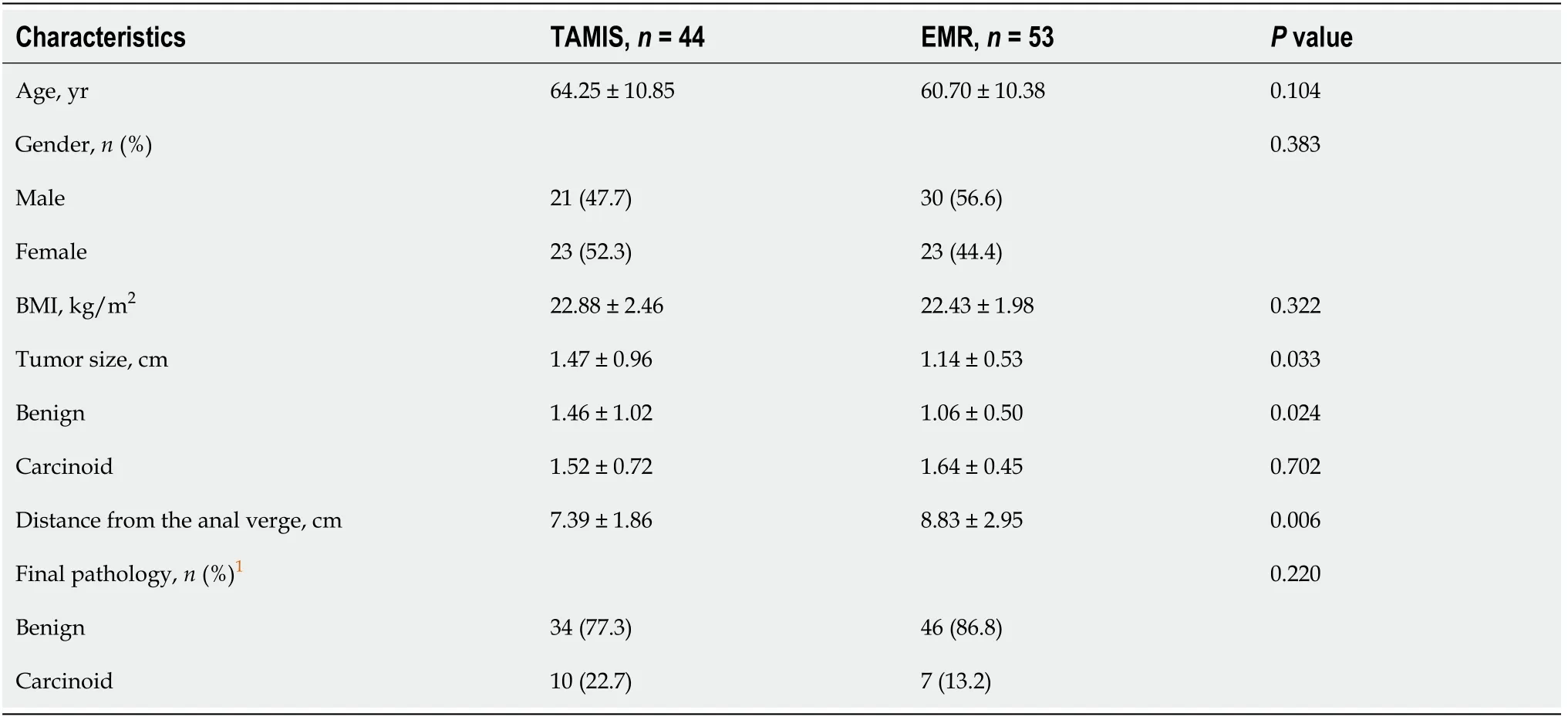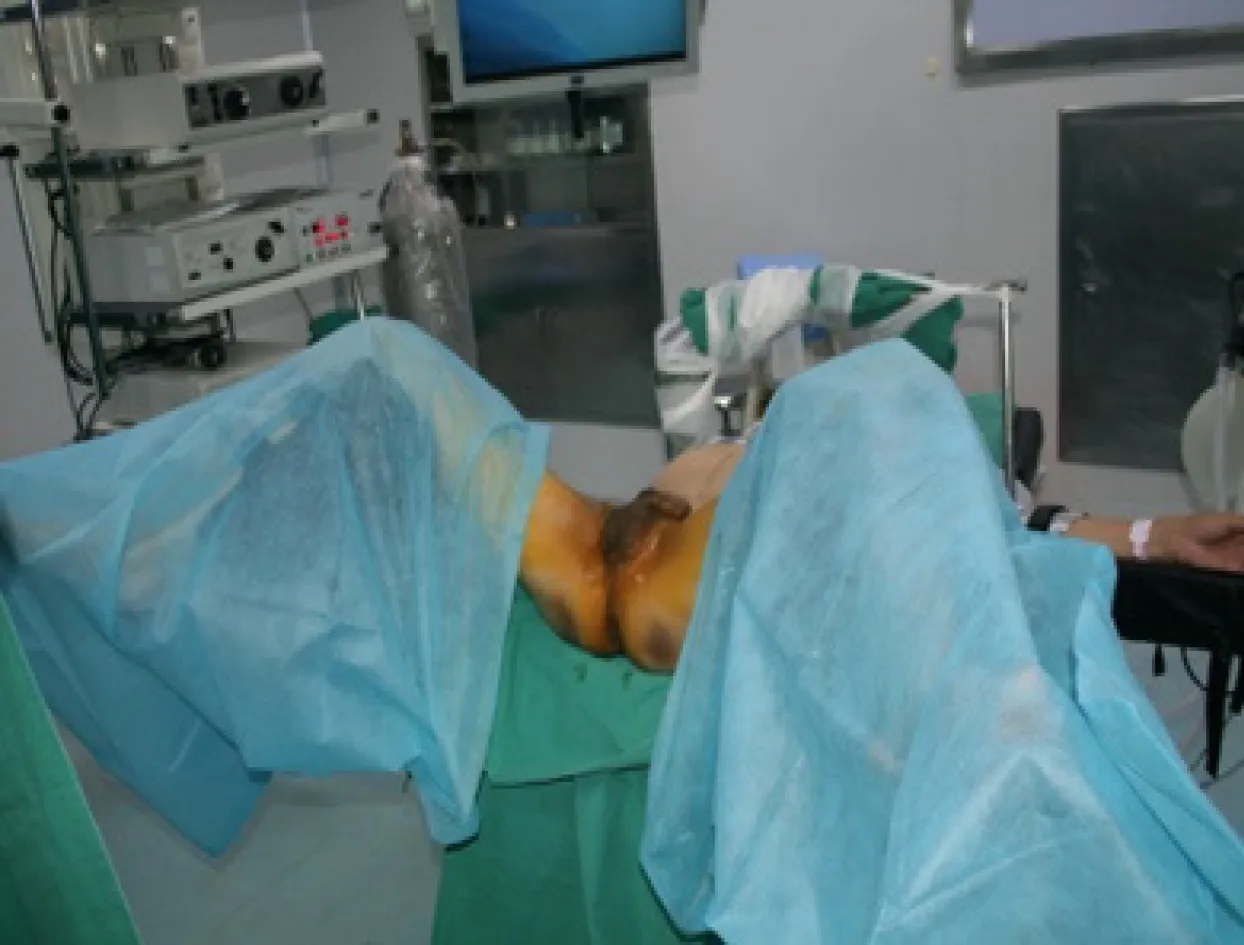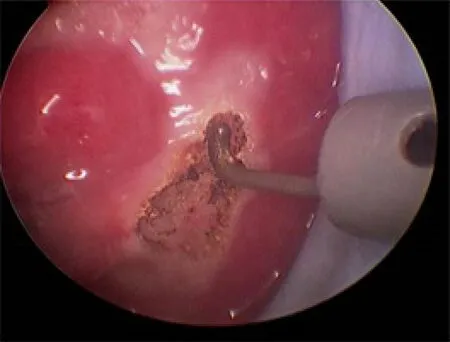Transanal minimally invasive surgery vs endoscopic mucosal resection for rectal benign tumors and rectal carcinoids:A retrospective analysis
Jia-Men Shen,Jia-Ying Zhao,Tao Ye,Li-Feng Gong,Hui-Peng Wang,Wen-Jie Chen,Yuan-Kun Cai
Jia-Men Shen,Jia-Ying Zhao,Tao Ye,Li-Feng Gong,Hui-Peng Wang,Wen-Jie Chen,Yuan-Kun Cai,Department of General Surgery,Shanghai Fifth People’s Hospital,Fudan University,Shanghai 200240,China
Abstract BACKGROUND Transanal minimally invasive surgery(TAMIS)is a good choice for resection of rectal neoplasms.Endoscopic mucosal resection(EMR)is also widely used in the treatment of benign rectal tumors such as rectal polyps and rectal adenomas.However,no studies have compared the outcome of TAMIS and EMR.AIM To compare the short-term outcomes after TAMIS and EMR for rectal carcinoid and benign tumors(including rectal polyps and adenomas).METHODS From January 2014 to January 2019,44 patients who received TAMIS and 53 patients who received EMR at The Fifth People’s Hospital of Shanghai were selected.Primary outcomes(surgical-related)were operating time,blood loss,length of postoperative hospital stay,rate of resection margin involvement and lesion fragmentation rate.The secondary outcomes were complications such as hemorrhage,urinary retention,postoperative infection and reoperation.RESULTS No significant differences were observed in terms of blood loss(12.48 ± 8.00 mL for TAMIS vs 11.45 ± 7.82 mL for EMR,P = 0.527)and length of postoperative hospital stay(3.50 ± 1.87 d for TAMIS vs 2.72 ± 1.98 d for EMR,P = 0.065)between the two groups.Operating time was significantly shorter for EMR compared with TAMIS(21.19 ± 9.49 min vs 49.95 ± 15.28 min,P = 0.001).The lesion fragmentation rate in the EMR group was 22.6%(12/53)and was significantly higher than that(0%,0/44)in the TAMIS group(P = 0.001).TAMIS was associated with a higher urinary retention rate(13.6%,6/44 vs 1.9%,1/53 P = 0.026)and lower hemorrhage rate(0%,0/44 vs 18.9%,10/53 P = 0.002).A significantly higher reoperation rate was observed in the EMR group(9.4%,5/53 vs 0%,0/44 P = 0.036).CONCLUSION Compared with EMR,TAMIS can remove lesions more completely with effective hemostasis and lower postoperative hemorrhage and reoperation rates.TAMIS is a better choice for the treatment of rectal carcinoids.
Key Words:Rectal neoplasms;Retrospective study;Anal canal surgery;Transanal endoscopic microsurgery/methods;Treatment outcome
INTRODUCTION
According to the 2018 global cancer statistics report,the incidence of colorectal cancer was ranked fourth after lung cancer,breast cancer and prostate cancer.In China,the morbidity and mortality of colorectal cancer rank second and fifth,respectively[1].Rectal adenoma is the main precancerous lesion of rectal cancer.Early and timely treatment of rectal adenoma and early rectal cancer can effectively reduce the morbidity and mortality of rectal cancer[2].Therefore,importance should be attached to the treatment of rectal adenoma and early rectal cancer.
Transanal excision can only treat lesions within 6 cm of the anal verge[3].However,transanal endoscopic microsurgery can treat early rectal cancer and benign rectal tumors ranging from 6 cm to 18 cm from the anal verge.Only a few surgery centers in China have transanal endoscopic microsurgery devices due to the cost and long learning curve involved[4-6].First proposed by Atallahet al[7]in 2009,transanal minimally invasive surgery(TAMIS)can solve the above problems.TAMIS combines single-incision laparoscopic surgery with more flexible transanal platforms,the learning curve is shorter and the purchase of expensive equipment can be avoided.In addition,TAMIS guarantees a good therapeutic effect in rectal polyps,rectal adenomas,early rectal cancer and other rectal mucosal lesions in the upper and middle rectum[8,9].
Endoscopic mucosal resection(EMR)is commonly used in the treatment of benign rectal tumors such as rectal polyps and rectal adenomas[10].However,no studies have compared the outcome of TAMIS and EMR.In this study,we retrospectively analyzed the data on TAMIS and EMR performed at The Fifth People’s Hospital of Shanghai,Fudan University.This study compared the short-term outcomes after TAMIS and EMR for rectal neoplasms.We hope that this study will help surgeons in the choice of treatment for benign rectal tumors and rectal carcinoids.
MATERIALS AND METHODS
Patient population
A total of 97 patients with rectal carcinoid and benign rectal diseases who received TAMIS and EMR in our hospital from January 2014 to January 2019 were selected.The patients were divided into the TAMIS group and EMR group according to the different surgical methods.
Inclusion criteria
The inclusion criteria were as follows:Age between 30 and 80 years;single rectal carcinoid and benign rectal diseases including polyps and adenomas at a distance of 5-15 cm from the anal verge;diameter of the lesion ≤ 3 cm;asymptomatic or only hematochezia present;no previous anorectal surgery;and no severe circulatory or respiratory diseases.
Exclusion criteria
The exclusion criteria were:The presence of other benign anorectal diseases such as anal fistula,hemorrhoids,perianal abscess,etc.;the presence of hemorrhagic disease,diabetes or other diseases that may affect the outcome;women who were pregnant or lactating.
Patient characteristics
There were no significant differences in age,gender,body mass index and pathological type between the two groups(P<0.05).Pathology was based on the pathological results after surgery,benign lesions included rectal polyps and rectal adenoma(Table 1).
Surgical procedures
Preoperative management:All patients were given a low-slag,liquid diet(prepared by Department of Nutrition,The Fifth People’s Hospital of Shanghai,Fudan University)and polyethylene glycol electrolyte powder enema 1 d before surgery.The patients were fasted for 8 h and no liquids were permitted 6 h prior to treatment.
TAMIS:The patients were given general anesthesia and placed in the lithotomy position(Figure 1).GelPOINT(Applied Medical,Rancho Santa Margarita,CA,United States)was fixed to the anus,and CO2pressure was maintained at 15 mmHg and 12 L/min(Figure 2).An airbag catheter was placed in the distal part of the surgical field,10-15 mL of air was injected into the airbag and the airbag was expanded to seal the proximal rectum(in some cases,this step was replaced by placing gauze 10 cm from the proximal end of the lesion).An electric hook was used to cut a distance of 0.5 cm from the tumor(Figure 3),the mucosa was incised and the submucosa or muscle layer was gradually incised,depending on the depth of the lesion,until the resection was complete.Closure of the rectal defect was performed with a free barbed suture.
EMR:Preoperative preparation was the same as for the TAMIS group.First,a normal saline solution containing epinephrine(0.01 mg/mL)was injected into the submucosa around the lesion to lift it away from the muscularis propria and thereby reduce the potential risk of perforation.A snare was then passed through the channel and opened around the lesion.The adequately lifted tumor was then snared and resected.Only whenen-blocresection was not feasible,fragmentary resection was allowed.Titanium clips were used for hemostasis.
Outcome evaluation
The primary outcomes in this study were surgical-related and included operating time,blood loss,length of postoperative hospital stay,rate of resection margin involvement and lesion fragmentation rate.Secondary outcomes were complications such as hemorrhage(hemorrhage was defined as self-limited hematochezia and melena that did not require endoscopic hemostasis after surgery),urinary retention,postoperative infection and reoperation.Reoperation included intestinal perforation repair,endoscopic clip hemostasis and radical resection of rectal carcinoid.
Statistical analysis
Categorical data are expressed as number and percentage.Continuous data are described as mean ± standard deviation.Differences between the groups were analyzed using the Chi-square test for categorical data and the one samplet-test forcontinuous data.The level of statistical significance was set atP<0.05.All data analyses were conducted using SPSS version 21.0 statistical software.

Table 1 Characteristics of the patients and tumors

Figure 1 Patient is positioned in the lithotomy position.
RESULTS
General findings
There were no significant differences in age,gender,body mass index and final pathology between the two groups.The mean distance from the anal verge in the TAMIS group was 7.39 ± 1.86 cm and was significantly shorter than that(8.83 ± 2.95 cm)in the EMR group(P= 0.006).The mean tumor size in the TAMIS group was 1.47± 0.96 cm,which was larger than that in the EMR group at 1.14 ± 0.53 cm(P= 0.033).The carcinoid size in the two groups was similar(1.52 ± 0.72,range 0.60-3.00 cm for TAMISvs1.64 ± 0.45,range 1.00-2.20 cm for EMR,P= 0.702).Only one carcinoid patient in the TAMIS group had a lesion smaller than 1 cm.
Surgical-related outcomes

Figure 2 Placement of the transanal minimally invasive surgery device.

Figure 3 Lesion excision by electric hook.
The mean operating time was sig nificantly shorter for TAMIS than for EMR:21.19 ±9.49 minvs49.95 ± 15.28 min,respectively(P<0.001).No significant differences in blood loss(P= 0.527),length of stay(P= 0.065)and resection margin involvement(P=0.109)were observed.The lesion fragmentation rate in the EMR group was 22.6%(12/53)and was significantly higher than 0%(0/44)in the TAMIS group(P= 0.001)(Table 2).
Postoperative complications
The rate of hemorrhage in the EMR group was 18.9%(10/53)and was significantly higher than 0%(0/44)in the TAMIS group(P= 0.026).The urinary retention rate was 13.6%(6/44)and 1.9%(1/53)in the TAMIS and EMR groups,respectively,and was significantly higher in the TAMIS group compared with the EMR group(P= 0.026).No significant difference was observed in the postoperative infection rate between the two groups.Five patients(9.4%)in the EMR group required reoperations,and none of the patients in the TAMIS group required reoperations(P= 0.036)(Table 3).
DISCUSSION
TAMIS is a type of minimally invasive surgery in which the single-hole laparoscopic channel is inserted into the anal canal and laparoscopic instruments are used to perform local resection of rectal lesions[11].Since Atallahet al[7]proposed TAMIS in 2009[7],TAMIS was quickly promoted worldwide with an excellent curative effect,reduced surgical trauma,fast postoperative recovery and low cost.TAMIS is mainly used in the treatment of middle and upper rectal polyps,adenomas and early rectal cancer 6-18 cm away from the anal verge[12,13].Currently,researchers have appliedTAMIS in the treatment of neuroendocrine tumors,low rectal anastomotic fistulas,rectal urethral fistulas and the removal of high rectal foreign bodies[14-16].In addition,robot-assisted TAMIS[17,18],transanal minimally invasive surgery for total mesorectal excision technology[19-21],TAMIS-laparoscopy combined technology[22]and endoscopicassisted TAMIS have also been rapidly developed[23].However,there are no available data comparing the outcomes of local excision of early rectal cancers and benign tumors using TAMIS and EMR.This study aimed to compare the short-term efficacy of TAMIS and EMR.

Table 2 Operative characteristics and outcome of transanal minimally invasive surgery and transanal minimally invasive surgery

Table 3 Complication rate of transanal minimally invasive surgery and transanal minimally invasive surgery
The mean distance from the anal verge in the TAMIS group was 7.39 ± 1.86 cm and was significantly shorter than 8.83 ± 2.95 cm in the EMR group(P= 0.006).The mean tumor size in the TAMIS group was 1.47 ± 0.96 cm,which was larger than that in the EMR group at 1.14 ± 0.53 cm(P= 0.033).These differences may have been caused by the tendency of doctors to choose certain surgical methods.For tumors with a larger diameter,surgeons are more likely to perform TAMIS,and for tumors further from the anus,they are more likely to perform EMR.In the EMR group,the mean tumor size of carcinoids was larger than that of rectal benign tumors(1.64 ± 0.45 cmvs1.06 ± 0.50 cm,P= 0.005),and three of seven patients with carcinoid underwent radical resection due to resection margin involvement.This result suggests that the lesion size should be taken into consideration in the selection of surgical methods.
No significant differences were observed in blood loss(P= 0.527)and length of postoperative stay(P= 0.065).The mean operating time in the TAMIS group was significantly longer than that in the EMR group(49.95 ± 15.28 minvs21.19 ± 9.49 min,P<0.001).In TAMIS,the establishment of pnuemorectum and placement of a singlehole laparoscope were required,which prolonged the operation time.
The rate of tumor-positive margin in the EMR group was 3.7%(3/53)and was slightly higher than 0%(0/44)in the TAMIS group(P= 0.109).The lesion fragmentation rate in the EMR group was 22.6%(12/53)and was significantly higher than 0%(0/44)in the TAMIS group(P= 0.001).These differences suggested that compared with EMR,TAMIS can completely resect rectal tumors without cutting the lesion itself,which is more in line with the principles of noncutting and monolithic resection in tumor surgery.It is also more suitable for the treatment of benign rectal diseases and rectal carcinoids.
The urinary retention rate in the TAMIS group was 13.6%(6/44)and was significantly higher than 1.9%(1/53)in the EMR group(P= 0.026).This may have been related to the difference in anesthesia between the two groups or due to stimulation of pelvic floor nerves during surgery.A significantly higher rate of hemorrhage was observed in the EMR group(0%,0/44vs18.9%,10/53P= 0.002).In the EMR group,high-frequency electrocoagulation and titanium clip clamping were used for hemostasis and wound closure.When the surgical incision is large,the effect of electrocoagulation hemostasis cannot be guaranteed,and the titanium clip has the risk of detachment.It has been reported that a lesion diameter greater than 2 cm increases the risk of hemorrhage after EMR[24].In the TAMIS group,the wound was closed with barbed absorbable sutures on the basis of ultrasonic coagulation,which effectively reduced the risk of postoperative bleeding.
In the EMR group,reoperations were performed in five cases,including one case of perforation,one case of postoperative bleeding and three cases of rectal carcinoid that underwent radical resection due to resection margin involvement.The reoperation rate in the EMR group was 9.4%(5/53)and was significantly higher than 0%(0/44)in the TAMIS group(P= 0.036).This result suggested that for patients with rectal carcinoids,TAMIS is a better choice because it can remove the lesions more completely.An airbag catheter was placed in the distal part of the surgical field and was inflated(in some cases,gauze was placed into the rectum about 10 cm from the proximal end of the lesion instead)to seal the proximal rectum and avoid interference due to intestinal secretions and fecal water in the surgical field of view.Pnuemorectum can also help to obtain a clearer surgical field of view and better expose the lesions to ensure complete and full-thickness resection of rectal tumors.
The database used in this study is based on real world data.As a retrospective study,avoiding major bias was a focus of the study.The surgeon’s choice of surgical method is affected by the severity of the disease,the size of the lesion and the distance of the lesion from the anus,which will directly affect the reliability of the results in this study.We eliminated this bias by matching and ensuring that the baseline patient characteristics in the two groups were similar.We selected patients who were asymptomatic or only had hematochezia,the diameter of the lesion was ≤ 3 cm and the distance of the lesion from the anal margin was 5-15 cm.
CONCLUSION
In summary,EMR is simpler and can be performed by a single person with a shorter operating time.In addition,EMR is less invasive and more suitable for the treatment of rectal polyps and adenomas with a longer distance from the anus.TAMIS surgery requires more surgical instruments,a larger surgical field,deeper and more thorough tumor resection,more effective hemostasis and results in lower hemorrhage and reoperation rates.It is a better choice for the treatment of rectal carcinoids.
ARTICLE HIGHLIGHTS
Research background
Transanal minimally invasive surgery(TAMIS)is a good choice for resection of benign lesions and carcinoids in the rectum.Endoscopic mucosal resection(EMR)is also widely used in the treatment of benign rectal tumors such as rectal polyps and rectal adenomas.However,no studies have compared the outcome of TAMIS and EMR.
Research motivation
We hope that this study will help surgeons in the choice of treatment for benign rectal lesions and rectal carcinoids.
Research objectives
We compared the short-term outcomes after TAMIS and EMR for rectal carcinoid and benign tumors(including rectal polyps and adenomas).
Research methods
The short-term outcomes after TAMIS and EMR for rectal carcinoids and benign tumors(including rectal polyps and adenomas)was compared.
Research results
TAMIS was associated with a higher urinary retention rate(13.6%,6/44vs1.9%,1/53P= 0.026)and lower hemorrhage rate(0%,0/44vs18.9%,10/53P= 0.002).A significantly higher reoperation rate was observed in the EMR group(9.4%,5/53vs0%,0/44P= 0.036).
Research conclusions
Compared with EMR,TAMIS can remove rectal tumors more completely with effective hemostasis and lower postoperative hemorrhage and reoperation rates.TAMIS is a better choice for the treatment of rectal carcinoids and benign rectal tumors with a large diameter.
Research perspectives
TAMIS surgery requires more surgical instruments,a larger surgical field,deeper and more thorough tumor resection,more effective hemostasis and results in lower hemorrhage and reoperation rates.It is a better choice for the treatment of rectal carcinoids.
 World Journal of Clinical Cases2020年19期
World Journal of Clinical Cases2020年19期
- World Journal of Clinical Cases的其它文章
- Role of monoclonal antibody drugs in the treatment of COVID-19
- Review of simulation model for education of point-of-care ultrasound using easy-to-make tools
- Liver injury in COVID-19:A minireview
- Impact of mTOR gene polymorphisms and gene-tea interaction on susceptibility to tuberculosis
- Establishment and validation of a nomogram to predict the risk of ovarian metastasis in gastric cancer:Based on a large cohort
- Predictive factors for early clinical response in community-onset Escherichia coli urinary tract infection and effects of initial antibiotic treatment on early clinical response
